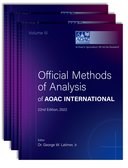 Official Methods of Analysis of AOAC INTERNATIONAL (22nd Edition)
Official Methods of Analysis of AOAC INTERNATIONAL (22nd Edition)
Contents
7.5.01
AOAC Official Method 953.05
Allethrin (Technical) and Pesticide Formulations: Titrimetric Method
Get access
-
Published:January 2023
Cite
Allethrin (Technical) and Pesticide Formulations: Titrimetric Method', in Dr. George W Latimer, Jr. (ed.), Official Methods of Analysis of AOAC INTERNATIONAL, 22nd Edition (
Extract
First Action 1953
Caution: See safety notes on pesticides.
Principle
Allethrin reacts quant. with ethylenediamine to form chrysanthemum monocarboxylic acid which is determined by titration with standard NaOMe in pyridine. Chrysanthemum monocarboxylic acid, anhydride, and acid chloride interfere quant. and are determined independently.
Reagents
...
Determination of Chrysanthemum Monocarboxylic Acid Chloride
Add 8–10 drops mixed indictor, B(g), to ca 150 mL anhydrous MeOH and add 0.1 N HCl, B(b), dropwise until solution appears reddish brown by transmitted light. Add 0.02 N KOH, B(d), dropwise until appearance of first green. Transfer 25 mL to each of three 125 mL glass-stoppered Erlenmeyers, reserving one flask as reference color for end point. Into each of other flasks, add 1.5–2.5 g sample from weighing pipet, swirling flask while adding sample. Within 5 min, titrate with 0.02 N KOH, B(d), to first green end point, using blank as reference color. Calculate milliequivalent chrysanthemum monocarboxylic acid chloride/g sample:
Sign in
Personal account
- Sign in with email/username & password
- Get email alerts
- Save searches
- Purchase content
- Activate your purchase/trial code
- Add your ORCID iD
Purchase
Our books are available by subscription or purchase to libraries and institutions.
Purchasing information| Month: | Total Views: |
|---|---|
| April 2024 | 6 |
| July 2024 | 7 |
| September 2024 | 3 |
| November 2024 | 1 |
| December 2024 | 5 |
| January 2025 | 2 |
| February 2025 | 3 |
| March 2025 | 3 |
| April 2025 | 2 |




Get help with access
Institutional access
Access to content on Oxford Academic is often provided through institutional subscriptions and purchases. If you are a member of an institution with an active account, you may be able to access content in one of the following ways:
IP based access
Typically, access is provided across an institutional network to a range of IP addresses. This authentication occurs automatically, and it is not possible to sign out of an IP authenticated account.
Sign in through your institution
Choose this option to get remote access when outside your institution. Shibboleth/Open Athens technology is used to provide single sign-on between your institution’s website and Oxford Academic.
If your institution is not listed or you cannot sign in to your institution’s website, please contact your librarian or administrator.
Sign in with a library card
Enter your library card number to sign in. If you cannot sign in, please contact your librarian.
Society Members
Society member access to a journal is achieved in one of the following ways:
Sign in through society site
Many societies offer single sign-on between the society website and Oxford Academic. If you see ‘Sign in through society site’ in the sign in pane within a journal:
If you do not have a society account or have forgotten your username or password, please contact your society.
Sign in using a personal account
Some societies use Oxford Academic personal accounts to provide access to their members. See below.
Personal account
A personal account can be used to get email alerts, save searches, purchase content, and activate subscriptions.
Some societies use Oxford Academic personal accounts to provide access to their members.
Viewing your signed in accounts
Click the account icon in the top right to:
Signed in but can't access content
Oxford Academic is home to a wide variety of products. The institutional subscription may not cover the content that you are trying to access. If you believe you should have access to that content, please contact your librarian.
Institutional account management
For librarians and administrators, your personal account also provides access to institutional account management. Here you will find options to view and activate subscriptions, manage institutional settings and access options, access usage statistics, and more.